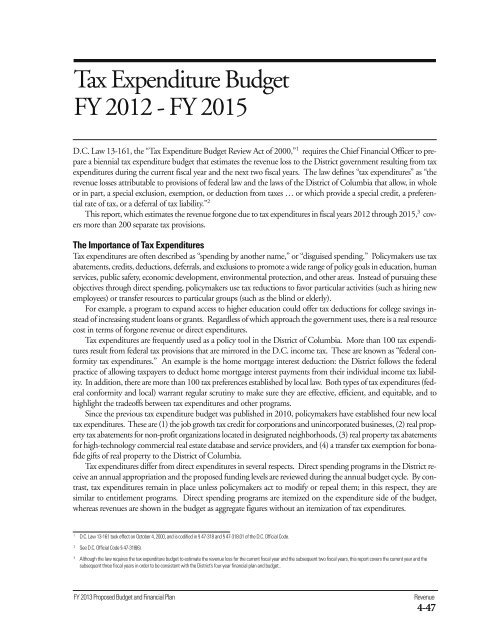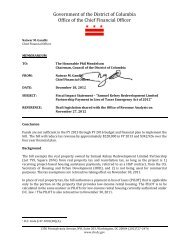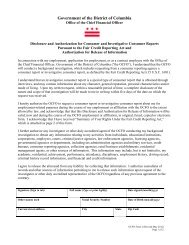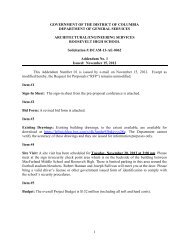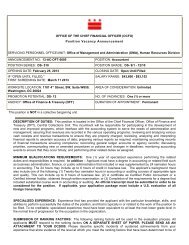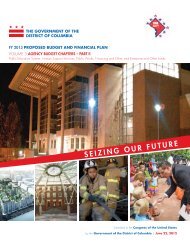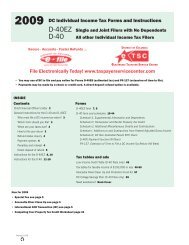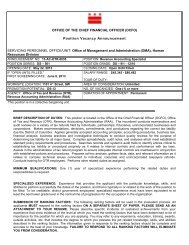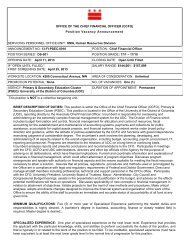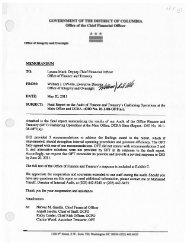Volume 1 - Executive Summary - Office of the Chief Financial Officer
Volume 1 - Executive Summary - Office of the Chief Financial Officer
Volume 1 - Executive Summary - Office of the Chief Financial Officer
You also want an ePaper? Increase the reach of your titles
YUMPU automatically turns print PDFs into web optimized ePapers that Google loves.
Tax Expenditure Budget<br />
FY 2012 - FY 2015<br />
D.C. Law 13-161, <strong>the</strong> “Tax Expenditure Budget Review Act <strong>of</strong> 2000,” 1 requires <strong>the</strong> <strong>Chief</strong> <strong>Financial</strong> <strong>Office</strong>r to prepare<br />
a biennial tax expenditure budget that estimates <strong>the</strong> revenue loss to <strong>the</strong> District government resulting from tax<br />
expenditures during <strong>the</strong> current fiscal year and <strong>the</strong> next two fiscal years. The law defines “tax expenditures” as “<strong>the</strong><br />
revenue losses attributable to provisions <strong>of</strong> federal law and <strong>the</strong> laws <strong>of</strong> <strong>the</strong> District <strong>of</strong> Columbia that allow, in whole<br />
or in part, a special exclusion, exemption, or deduction from taxes … or which provide a special credit, a preferential<br />
rate <strong>of</strong> tax, or a deferral <strong>of</strong> tax liability.” 2<br />
This report, which estimates <strong>the</strong> revenue forgone due to tax expenditures in fiscal years 2012 through 2015, 3 covers<br />
more than 200 separate tax provisions.<br />
The Importance <strong>of</strong> Tax Expenditures<br />
Tax expenditures are <strong>of</strong>ten described as “spending by ano<strong>the</strong>r name,” or “disguised spending.” Policymakers use tax<br />
abatements, credits, deductions, deferrals, and exclusions to promote a wide range <strong>of</strong> policy goals in education, human<br />
services, public safety, economic development, environmental protection, and o<strong>the</strong>r areas. Instead <strong>of</strong> pursuing <strong>the</strong>se<br />
objectives through direct spending, policymakers use tax reductions to favor particular activities (such as hiring new<br />
employees) or transfer resources to particular groups (such as <strong>the</strong> blind or elderly).<br />
For example, a program to expand access to higher education could <strong>of</strong>fer tax deductions for college savings instead<br />
<strong>of</strong> increasing student loans or grants. Regardless <strong>of</strong> which approach <strong>the</strong> government uses, <strong>the</strong>re is a real resource<br />
cost in terms <strong>of</strong> forgone revenue or direct expenditures.<br />
Tax expenditures are frequently used as a policy tool in <strong>the</strong> District <strong>of</strong> Columbia. More than 100 tax expenditures<br />
result from federal tax provisions that are mirrored in <strong>the</strong> D.C. income tax. These are known as “federal conformity<br />
tax expenditures.” An example is <strong>the</strong> home mortgage interest deduction: <strong>the</strong> District follows <strong>the</strong> federal<br />
practice <strong>of</strong> allowing taxpayers to deduct home mortgage interest payments from <strong>the</strong>ir individual income tax liability.<br />
In addition, <strong>the</strong>re are more than 100 tax preferences established by local law. Both types <strong>of</strong> tax expenditures (federal<br />
conformity and local) warrant regular scrutiny to make sure <strong>the</strong>y are effective, efficient, and equitable, and to<br />
highlight <strong>the</strong> trade<strong>of</strong>fs between tax expenditures and o<strong>the</strong>r programs.<br />
Since <strong>the</strong> previous tax expenditure budget was published in 2010, policymakers have established four new local<br />
tax expenditures. These are (1) <strong>the</strong> job growth tax credit for corporations and unincorporated businesses, (2) real property<br />
tax abatements for non-pr<strong>of</strong>it organizations located in designated neighborhoods, (3) real property tax abatements<br />
for high-technology commercial real estate database and service providers, and (4) a transfer tax exemption for bonafide<br />
gifts <strong>of</strong> real property to <strong>the</strong> District <strong>of</strong> Columbia.<br />
Tax expenditures differ from direct expenditures in several respects. Direct spending programs in <strong>the</strong> District receive<br />
an annual appropriation and <strong>the</strong> proposed funding levels are reviewed during <strong>the</strong> annual budget cycle. By contrast,<br />
tax expenditures remain in place unless policymakers act to modify or repeal <strong>the</strong>m; in this respect, <strong>the</strong>y are<br />
similar to entitlement programs. Direct spending programs are itemized on <strong>the</strong> expenditure side <strong>of</strong> <strong>the</strong> budget,<br />
whereas revenues are shown in <strong>the</strong> budget as aggregate figures without an itemization <strong>of</strong> tax expenditures.<br />
1<br />
D.C. Law 13-161 took effect on October 4, 2000, and is codified in § 47-318 and § 47-318.01 <strong>of</strong> <strong>the</strong> D.C. Official Code.<br />
2<br />
See D.C. Official Code § 47-318(6).<br />
3<br />
Although <strong>the</strong> law requires <strong>the</strong> tax expenditure budget to estimate <strong>the</strong> revenue loss for <strong>the</strong> current fiscal year and <strong>the</strong> subsequent two fiscal years, this report covers <strong>the</strong> current year and <strong>the</strong><br />
subsequent three fiscal years in order to be consistent with <strong>the</strong> District’s four-year financial plan and budget..<br />
FY 2013 Proposed Budget and <strong>Financial</strong> Plan<br />
Revenue<br />
4-47


